Abgoosht & Dizi | Traditional Persian Stew Recipe
For every avid foodie, there's an unparalleled thrill in exploring the flavors of different cultures. And when it comes to Persian food, Abgoosht takes center stage as a must-try dish.
Abgoosht, also known as Dizi when served in stone crock pots, is an iconic traditional stew in Iran. It has been passed down through generations, evolving its ingredients and recipes across different regions of the country.
Abgoosht was initially prepared with lamb, onion, and chickpeas; modern variations often include tomatoes and potatoes. Regardless of the specific recipe, the serving style remains consistent throughout Iran.
Join us on this gastronomic journey as we unravel the secrets behind Iranian dizi recipe, ingredients, variations, how it is served, and how to eat this traditional Persian food.
What is Abgoosht?
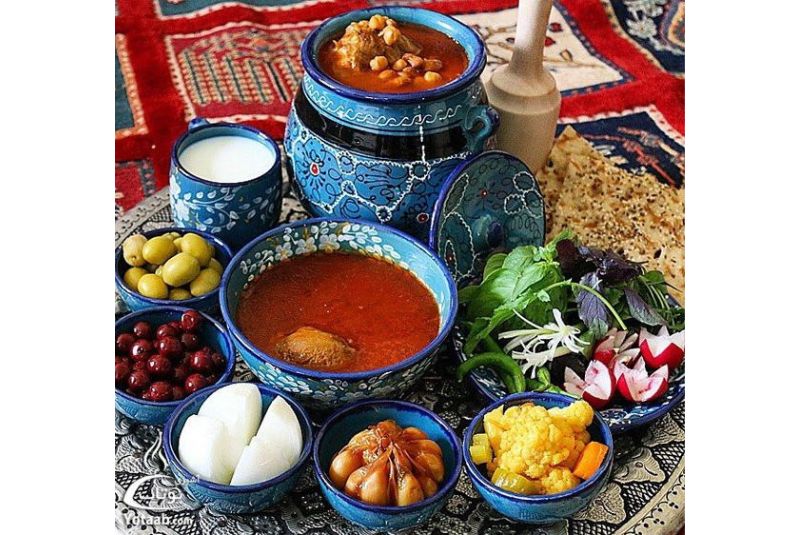
Abgoosht, also known as Dizi, is a traditional Persian dish that traces its origins back to the Safavid era. It was initially known as Dizi, named after the small stone dishes in which it was cooked and served. These stone dishes, called Dizi, were an integral part of the culinary culture in Iran. Even today, traditional Iranian establishments proudly maintain this practice, using the iconic stone dishes to prepare and present Abgoosht.
Abgoosht translates as "Meat Juice" (ab stands for water and goosht for meat). It is a slow-cooked, simple, and down-to-earth meal that satisfies hunger, nourishes the body, and brings immense satisfaction. This high-calorie dish is particularly favored during the winter season.
In its earliest form, Abgoosht consisted solely of lamb, onion, and chickpeas. However, as Iranian cuisine evolved and the influence of new world foods took hold, the Abgoosht recipe transformed. So many ingredients, such as tomatoes, potatoes, and dried lime, have been added to the Abgoosht ingredients.
One unique aspect of Abgoosht is the custom of straining the solid parts of the dish into a bowl and mashing them with goosht-koob (a meat muddler) until they reach a soft texture. This mixture, known as Goosht-Koubideh, is typically enjoyed with warm oriental bread, herbs, and raw onion. The liquid portion of Abgoosht is consumed as a soup, often paired with cracked and soaked bread.
To enhance the dining experience, Abgoosht is complemented by various side dishes. These may include Torshi (pickled vegetables), fresh herbs like reddish and basil, and strained yogurt with shallots. Additionally, a fermented savory yogurt-based beverage mixed with dried herbs is commonly served alongside Abgoosht. The meal concludes with a cup of hot black tea accompanied by rock candy or other Persian sweets.
| Discover: Unusual Foods in Iran - Weirdly Wonderful Dishes
Abgoosht Ingredients
To prepare this hearty meal, you will need the following ingredients:
- 2½ pounds bone-in lamb shank
- One teaspoon of ground turmeric
- Fine sea salt and freshly ground black pepper
- ½ cup dried chickpeas
- ½ cup dried white beans, such as navy or cannellini
- Two large yellow onions, quartered
- ¼ cup tomato paste
- Three large russet potatoes (about 2 pounds)
- 6 Omani (dried Persian) limes, rinsed and punctured multiple times with a fork
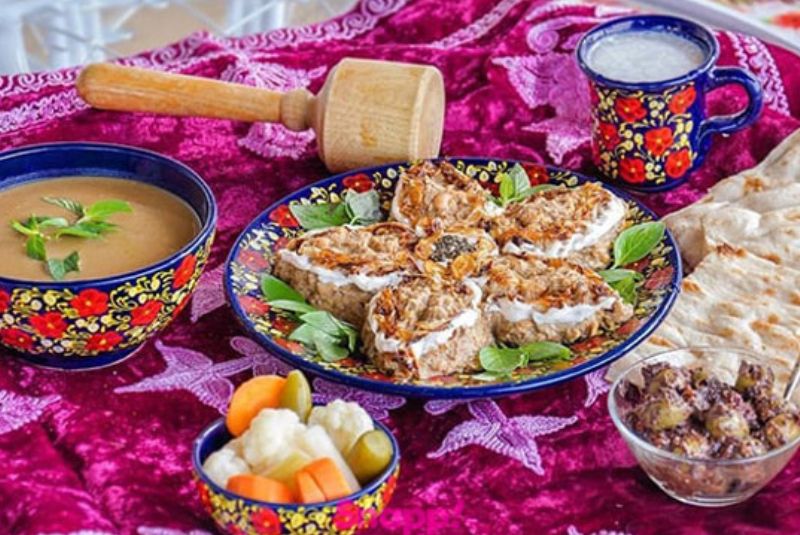
Optional Ingredients for Serving
- Persian liteh pickles
- Salad-e Shirazi
- Warmed sangak bread or other freshly baked flatbreads
- Assorted fresh herbs (such as mint, tarragon, and basil), scallions, and radishes
- Doogh (Persian yogurt drink)
| Read more: Ash Reshteh - An Iranian Soup for Special Occasions
Abgoosht Recipe in 8 Steps
The preparation of Abgoosht involves an ancient cooking method that utilizes clay or stone cookware. The Abgoosht pot is usually placed over indirect heat or a slow fire, allowing the ingredients to simmer and meld together over several hours until they reach their optimum flavors. Although modern kitchens may not commonly employ clay pots for cooking, the tradition continues as the clay pot is still cherished as a vessel for serving this beloved dish. If you want to cook Abgoosht for yourself or your family at home, here is a detailed step-by-step guide to preparing Abgoosht:
Step 1
The night before cooking, season the lamb with turmeric, salt, and pepper. Cover it and refrigerate. In a separate bowl, soak the chickpeas and beans in water with a pinch of salt. Refrigerate them overnight.
Step 2
When you're ready to cook, heat a large Dutch oven or soup pot over high heat. Add the seasoned lamb, onions, tomato paste, and 8 cups of water. Drain the soaked chickpeas and beans and add them to the pot. Bring everything to a boil, stirring to dissolve the tomato paste. Partially cover the pot with a lid, reduce the heat, and let the stew simmer for 2 hours.
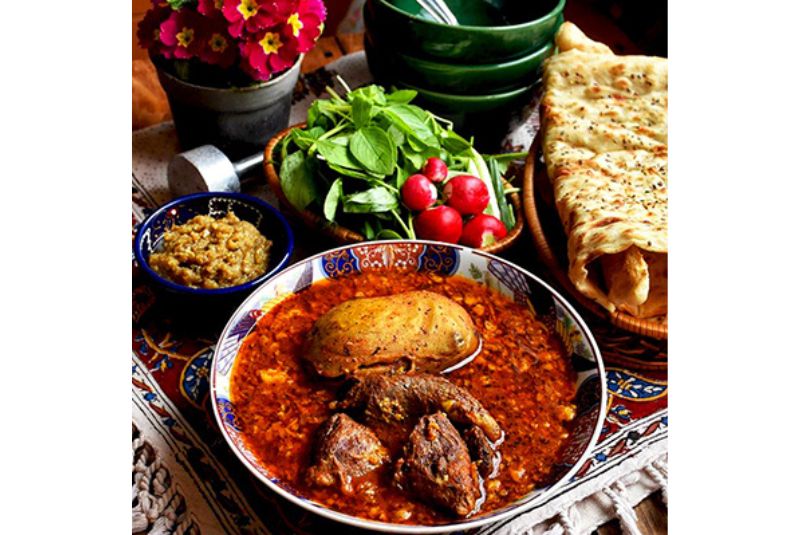
Step 3
Peel the potatoes and cut them into 1-inch pieces. Add the potatoes and Omani limes to the pot and continue simmering until the potatoes and meat are tender, which should take about 1 hour. Taste the broth and adjust the seasoning with salt and pepper according to your preference.
Step 4
Remove the Omani limes from the pot. Juice each lime into the soup through a sieve, using a spoon to press down on them. Make sure to avoid letting the seeds through the sieve, as they can be bitter. Taste the broth after juicing each lime and add just enough juice to make the broth tangy and bright.
Step 5
Using the sieve, remove the meat, potatoes, and beans from the pot and transfer them to a large bowl. Use a fork to pull the meat off the bones. If there is marrow in any of the bones, use a skewer to remove it and add it to the bowl. Mash the meat, beans, and potatoes into a soft and uniform paste using a potato masher. This paste is called goosht kubideh. If the mixture seems dry, add a few spoonfuls of broth and continue mashing until it becomes smooth and unctuous. Taste the paste and adjust the seasoning with salt, pepper, and Omani lime juice as needed.
Step 6
To serve, bring the broth and goosht kubideh to the table. Serve them alongside liteh pickles, salad-e Shirazi, warmed sangak bread, fresh herbs, and doogh (if desired). These sides help balance the richness of the dish and serve as palate cleansers.
Step 7
Traditionally, start by eating the broth with torn pieces of sangak bread. The bread is added to the broth and soaked for a couple of minutes before eating. This process is known as tileet.
Step 8
After everyone has enjoyed a bowl of broth, serve the goosht kubideh separately. Traditionally, the meat paste is made into small sandwiches with fresh herbs and eaten with alternating bites of salad-e Shirazi and liteh pickle. Leftover goosht kubideh can be used for sandwiches or baby food, and it can be frozen for up to 2 weeks.
| Also read about: Top 20 Persian Snacks - Taste the Best
Variations of Abgoosht
Different cities in Iran have their own unique versions of Abgoosht and Dizi. Here are some of the different types of Abgoosht you can find in different cities of Iran:
Kerman Abgoosht
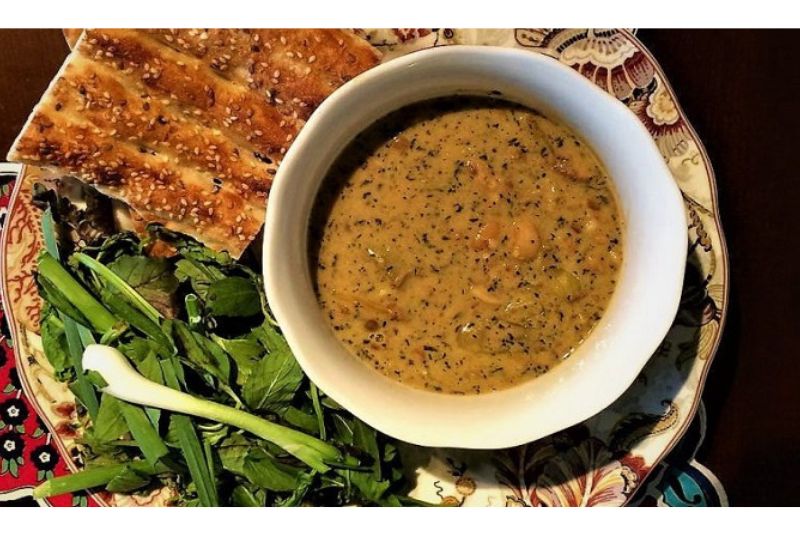
In Kerman, Abgoosht is prepared with meat, lots of caraway, and garlic. Unlike the traditional version, they don't add potatoes or beans to the stew.
Abgoosht Bozbash
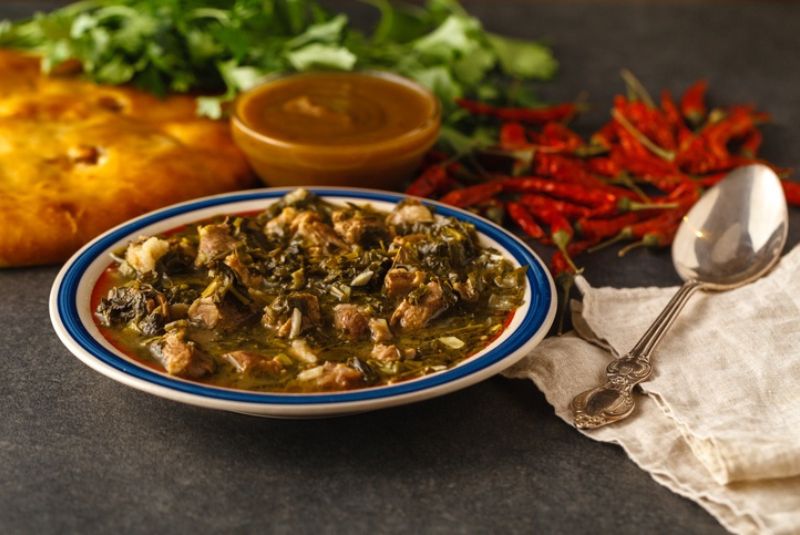
Abgoosht Bozbash is commonly cooked in Tabriz. Instead of chickpeas, they use cowpeas and incorporate chives, parsley, and fenugreek. This variation has a predominantly green color compared to the traditional red Abgoosht.
| Discover: Kufteh & Dolma - Delicious Persian Food
Vegan Abgoosht
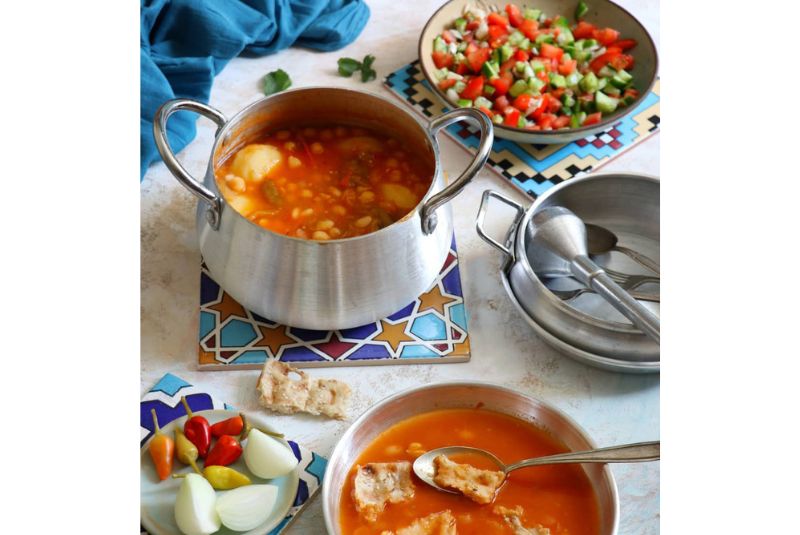
The abgoosht recipe for vegetarians includes skipping the meat and increasing the beans. If you want, you can even add non-vegan miso paste or mushroom broth to increase the umami flavor. You can also add roasted eggplant, okra, bell peppers, root vegetables, etc.
| Suggestion: Iranian Vegetarian Foods
Abgoosht Baghi
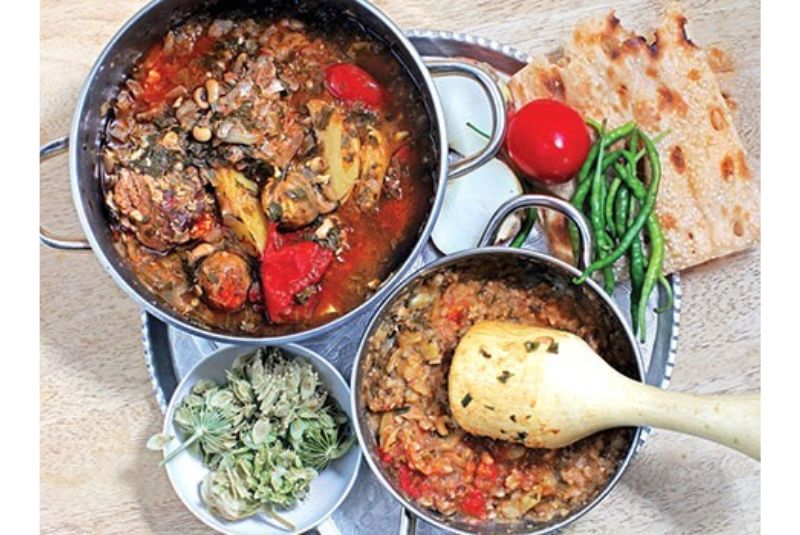
Abgoosht Baghi, named after the word "Bagh," meaning garden, includes all the traditional ingredients along with a variety of fruits such as peach, apple, cherry, and apricot. These fruits add a unique twist to the dish.
Abgoosht in Other Countries
These are some of the most popular variations of Abgoosht found in Iran. However, Abgoosht has also traveled beyond Iran's borders and influenced the culinary cultures of neighboring countries. Here are a few examples:
Piti (Caucasus and Central Asia)
Piti, also known as Putuk, is a variation of Abgoosht found in the cuisines of the Caucasus and Central Asia. It shares similarities with Abgoosht but has its own distinct flavors and cooking techniques.
| Suggestion: Top 23 Iranian Kebab
Tashreeb (Iraq)
In Iraq, a similar cooking pattern to Dizi is followed, known as Tashreeb. It has assimilated into Iraqi culinary traditions and is enjoyed by the local population.
Assyrian Abgoosht
Assyrians residing in northwestern Iran, particularly around Urmia, have their own version of Abgoosht. It typically includes beef, lime, kidney beans, and chickpeas, served in a lime broth with potatoes. Assyrians traditionally consume Abgoosht in the winter.
Armenian Abgoosht
Armenia also has its own version of Abgoosht, where beef is used instead of lamb.
| Read more: Traditional Persian Breakfast You Should Try
How is Abgoosht Served?
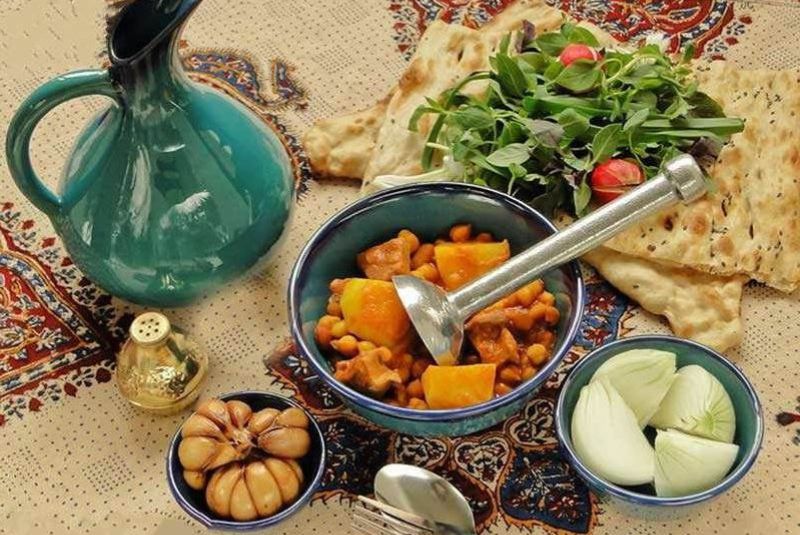
When it comes to serving Abgoosht, there are several traditional and modern ways to enjoy this delightful Persian dish. Here's a breakdown of the different serving styles:
Goosht Koobideh
In the traditional Persian style, the solid parts of Abgoosht, including the meat (de-boned), potatoes, and beans, are separated from the broth. These solid ingredients are then pounded into a mash using a mallet called goosht-koob. The resulting meat mash has a texture similar to fillings used in dishes like tuna salad, chicken salad, or refried beans. It is usually a bit lumpy and not a smooth paste.
Tileet
Another way to savor Abgoosht is by serving the flavorful broth separately. The broth is poured into a bowl and topped with bite-sized pieces of flatbread. The bread soaks up the broth, creating a delicious combination of flavors and textures. This serving style is called Tileet and allows you to enjoy the broth-soaked bread as you savor the rich flavors of Abgoosht.
Sandwiches/Wraps
Another popular way to enjoy Abgoosht is by creating sandwiches or wraps. The mashed meat from the goosht koobideh is spread on warm Persian flatbreads such as sangak or lavash. Sliced radishes, fresh herbs, and pickles are added as toppings. The flatbread is then rolled or folded, creating a flavorful and portable meal that can be enjoyed as a wrap or small sandwich.
Homestyle
Abgoosht is often enjoyed at home as a chunky soup without separating the contents from the broth. In this style, the meat, potatoes, and beans remain in the broth, creating a comforting and hearty soup. This homestyle serving is a convenient and delicious way to enjoy Abgoosht without the extra step of pounding the ingredients into a mash.
Appetizers
For a modern twist, you can get creative with serving Abgoosht. One option is to serve the mashed meat and broth on dried crackers or toasted bread. Garnish with fresh herbs for added flavor and visual appeal. This appetizer-style serving is a great way to introduce Abgoosht to guests or enjoy it as a light snack.
| Suggestion: Top 17 Iranian Seafood Cuisine
What to Serve Along
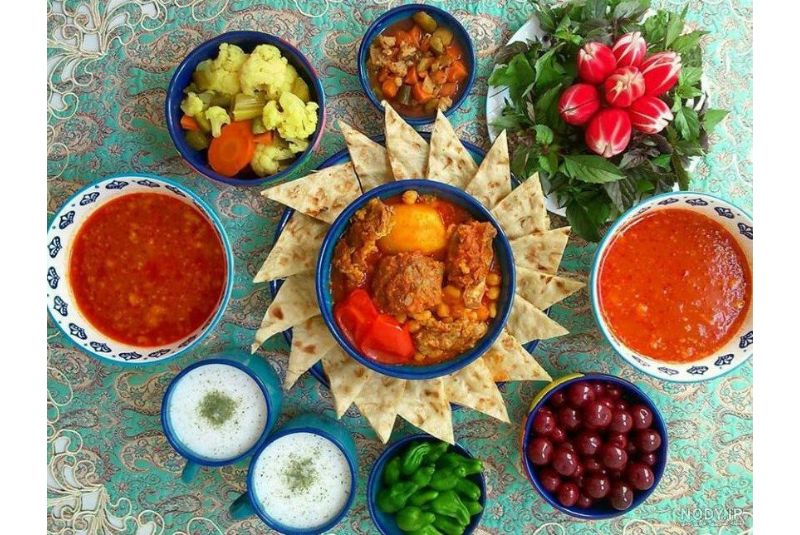
When it comes to serving Abgoosht, traditional accompaniments can enhance the overall experience and complement the flavors of the dish. Here are some popular options to consider:
Flatbreads
You can serve it with traditional Persian flatbreads like sangak (stone-baked bread) or lavash. These breads are perfect for scooping up the delicious stew. If you don't have access to sangak or lavash, you can also use barbari bread or whole wheat pita as alternatives.
Salad
A refreshing salad like Shirazi salad pairs wonderfully with Abgoosht. Shirazi salad typically consists of diced cucumbers, tomatoes, onions, and herbs like mint and parsley.
Beverage
Doogh, a traditional Persian yogurt drink, is a popular choice to accompany Abgoosht. Its refreshing and tangy nature complements the flavors of the stew. Doogh is made by combining yogurt, water, and dried mint, resulting in a cooling and savory beverage.
| Related: Best Iranian Beverages and Drinks
Sabzi Khordan
Sabzi Khordan refers to an assortment of fresh herbs and vegetables that are served alongside Abgoosht. To make Sabzi Khordan, arrange a platter with radishes, green onions, basil, tarragon, mint, cilantro, and watercress. You can also include some feta cheese to enhance the flavor combination.
Persian Pickles (Torshi)
Lastly, you add a tangy and savory element to your Abgoosht experience by serving it with Persian pickles, also known as Torshi. These pickles are typically made from a variety of vegetables or fruits that are pickled in vinegar and spices.
| Also might be interesting: Famous Iranian Desserts You Must Try
Bottom Line
Abgoosht is a traditional Persian stew made with tender lamb, hearty beans, and potatoes simmered in a rich broth that offers a comforting and flavorful experience. Whether you're planning a trip to this beautiful country and want to savor Abgoosht's tender meat, flavorful broth, and aromatic spices, Or perhaps you want to explore new flavors in your own kitchen at home and recreate this comforting dish in your own kitchen. One thing is for certain: Abgoosht is a taste worth discovering.
Share your story!
Comment below and let us know about your Experience.
Your story inspires others!


Comment
Leave a Comment